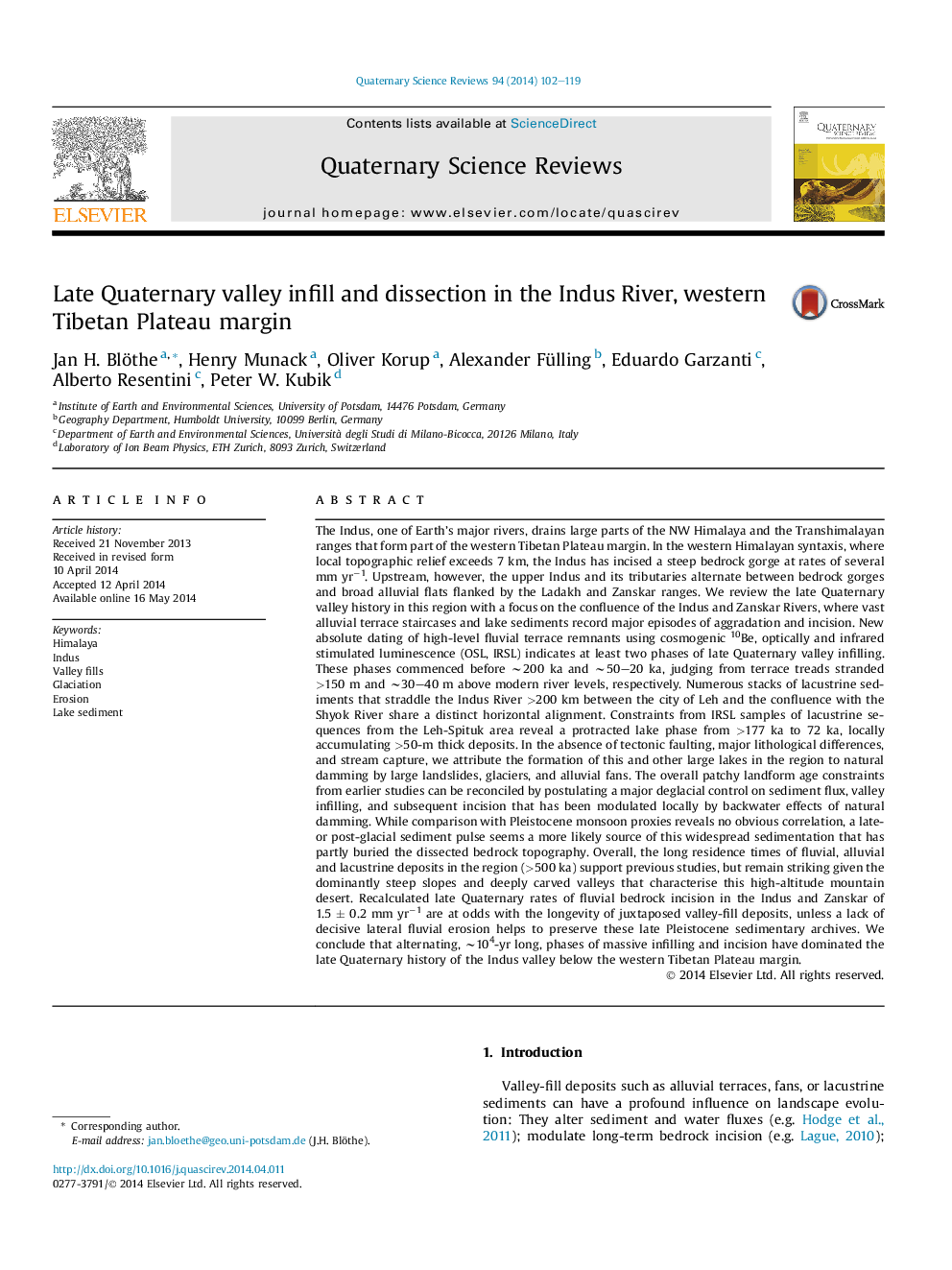| کد مقاله | کد نشریه | سال انتشار | مقاله انگلیسی | نسخه تمام متن |
|---|---|---|---|---|
| 4736505 | 1640840 | 2014 | 18 صفحه PDF | دانلود رایگان |

• Quaternary history of W Tibetan plateau margin: massive infill and incision phases.
• Stranded former valley floors up to ∼500 ka old; amongst oldest in Himalaya.
• Late- or post-glacial instead of monsoonal control on sediment flux.
• Palaeolakes in the region older and more long-lived than assumed previously.
• Long residence times of landforms at odds with dissected bedrock topography.
The Indus, one of Earth's major rivers, drains large parts of the NW Himalaya and the Transhimalayan ranges that form part of the western Tibetan Plateau margin. In the western Himalayan syntaxis, where local topographic relief exceeds 7 km, the Indus has incised a steep bedrock gorge at rates of several mm yr−1. Upstream, however, the upper Indus and its tributaries alternate between bedrock gorges and broad alluvial flats flanked by the Ladakh and Zanskar ranges. We review the late Quaternary valley history in this region with a focus on the confluence of the Indus and Zanskar Rivers, where vast alluvial terrace staircases and lake sediments record major episodes of aggradation and incision. New absolute dating of high-level fluvial terrace remnants using cosmogenic 10Be, optically and infrared stimulated luminescence (OSL, IRSL) indicates at least two phases of late Quaternary valley infilling. These phases commenced before ∼200 ka and ∼50–20 ka, judging from terrace treads stranded >150 m and ∼30–40 m above modern river levels, respectively. Numerous stacks of lacustrine sediments that straddle the Indus River >200 km between the city of Leh and the confluence with the Shyok River share a distinct horizontal alignment. Constraints from IRSL samples of lacustrine sequences from the Leh-Spituk area reveal a protracted lake phase from >177 ka to 72 ka, locally accumulating >50-m thick deposits. In the absence of tectonic faulting, major lithological differences, and stream capture, we attribute the formation of this and other large lakes in the region to natural damming by large landslides, glaciers, and alluvial fans. The overall patchy landform age constraints from earlier studies can be reconciled by postulating a major deglacial control on sediment flux, valley infilling, and subsequent incision that has been modulated locally by backwater effects of natural damming. While comparison with Pleistocene monsoon proxies reveals no obvious correlation, a late- or post-glacial sediment pulse seems a more likely source of this widespread sedimentation that has partly buried the dissected bedrock topography. Overall, the long residence times of fluvial, alluvial and lacustrine deposits in the region (>500 ka) support previous studies, but remain striking given the dominantly steep slopes and deeply carved valleys that characterise this high-altitude mountain desert. Recalculated late Quaternary rates of fluvial bedrock incision in the Indus and Zanskar of 1.5 ± 0.2 mm yr−1 are at odds with the longevity of juxtaposed valley-fill deposits, unless a lack of decisive lateral fluvial erosion helps to preserve these late Pleistocene sedimentary archives. We conclude that alternating, ∼104-yr long, phases of massive infilling and incision have dominated the late Quaternary history of the Indus valley below the western Tibetan Plateau margin.
Journal: Quaternary Science Reviews - Volume 94, 15 June 2014, Pages 102–119